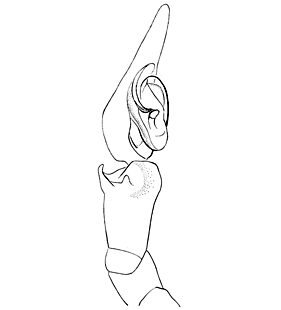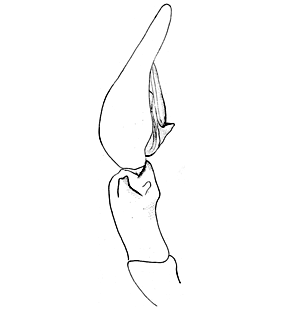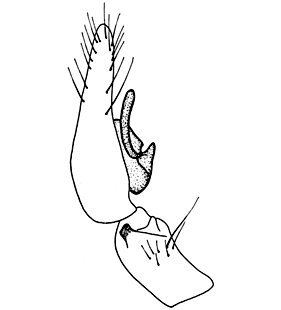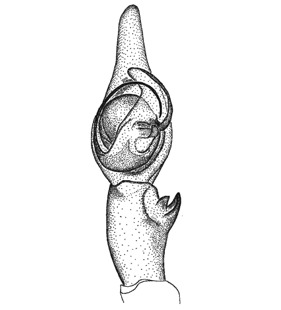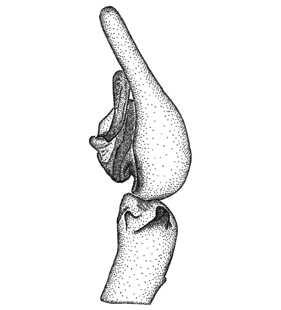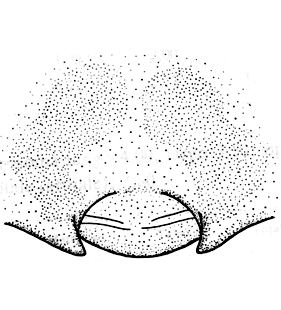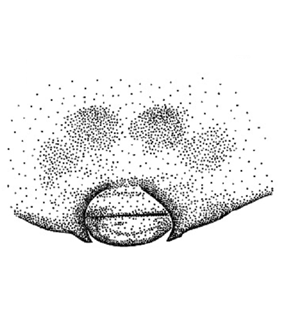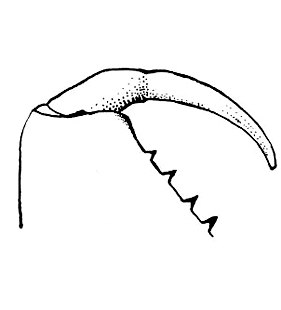Aterigena soriculata (Simon, 1873)
Description
Male
Male palp: RTA with large dorsal branch, distally truncated and strongly sclerotized; lateral branch developed as a weakly sclerotized point; ventrally bearing a weakly developed rounded ridge. Embolus originating (free apex) between 7 and 8 o’clock position; length (only free apex) less than 1.75 times cymbium width; distal tip between 2 and 3 o’clock position. Conductor lamella-like, distally elongated (parallel to cymbium), arcuated and laterally folded along the whole length; as long as alveolus, distally reaching beyond alveolus margin; terminal end forming sclerotized peak, pointing ventrally (in lateral view). Connection of conductor and tegulum membranous. Median apophysis originating between 4 and 5 o’clock position. Tegular apophysis absent. Prosoma length: 4.47 mm.
Female
Epigynum and vulva: Epigynal plate sclerotized with distinct atrium, transversely oval in shape; anterior margin of atrium sclerotized at epigynal plate, gradually becoming membranous. Ground plate of atrium transversally subdivided by straight groove: anterior part membranous or weakly sclerotized, semicircular in shape; posterior part sclerotized, forming semicircular bar. Copulatory openings barely visible, located medially of atrium. Copulatory duct short and straight. Receptacula small, globular; fertilization ducts long and strongly convoluted. Prosoma length: 4.14–5.07 mm.
Additional information
Eyes: Diameter: PME: 0.17–0.18; PLE: 0.18–0.21; AME: 0.13–0.18; ALE: 0.19–0.21. Distances: PME–PME less than diameter of PME; PME–AME less than or equal to diameter of PME; PME–PLE less than or equal to diameter of PME; PME–ALE less than 1.5 diameter of PME; AME–AME about 0.5 diameter of AME. Clypeus height (measured under AME) less than 2.5 times diameter of AME; (measured under ALE) about 1.5 times diameter of ALE.
Coloration: Two longitudinal symmetrical dark bands present on carapace, interrupted, sometimes reduced to triangular dots, intensified by white and black plumose hairs. Opisthosoma dark green-brownish, at the cardiac mark yellowish with dots on the sides, continuing in broad chevrons posteriorly. Legs not annulated.
Additional somatic characters: Tarsus I with 7–8 dorsal trichobothria, tarsi II–IV with 7. Colulus dark, sometimes only partially. Both segments of PLS very weakly darkened. PMS slightly smaller than ALS.
Distribution
Phenology
| Jan | Feb | Mar | Apr | May | Jun | Jul | Aug | Sep | Oct | Nov | Dec |
 |  |
Figures
Distribution List
"No references" does not mean that the species does not occur in this country, but that we have not yet inserted the reference for it. We are working on it.
References
Bolzern A, Hänggi A, Burckhardt D (2010) Aterigena, a new genus of funnel-web spider, shedding some light on the Tegenaria-Malthonica problem (Araneae: Agelenidae) Journal of Arachnology 38: 162-182 ![]()
Brignoli P M (1974a) Ragni d'Italia XXI. Settimo contributo alla conoscenza dei ragni cavernicoli di Sardegna e descrizione di una nuova specie di Corsica (Araneae). Revue Suisse de Zoologie 81: 387-395 ![]()
Dresco E, Célérier M-L (1980) Étude des tégénaires. Tegenaria soriculata Simon 1873 et Tegenaria cyrnea Brignoli 1974 (Araneae, Agelenidae). Bulletin de la Société Zoologique de France 104: 221-231 ![]()
Le Peru B (2007) Catalogue et répartition des araignées de France. Revue Arachnologique 16: 1-468 ![]()
Pantini P, Isaia M (2019) Araneae.it: the online catalog of Italian spiders, with addenda on other arachnid orders occurring in Italy (Arachnida: Araneae, Opiliones, Palpigradi, Pseudoscorpionida, Scorpiones, Solifugae). Fragmenta Entomologica 51: 127-152 ![]()
WSC (2024) World Spider Catalog. Version 25.5. Natural History Museum Bern, online at http://wsc.nmbe.ch (31.10.2024) doi: 10.24436/2 ![]()
